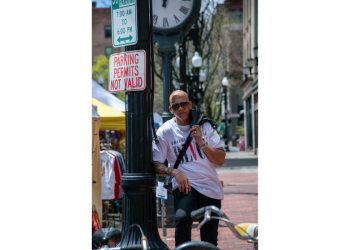But the 300-pound Price posted himself right outside the White House gate, day after day, rain or shine. And he ambushed those going through it.
“When politicians calling on President Cleveland emerged, ‘Fatty’ Price buttonholed them and milked them of what news they were willing to give down,” New York Times reporter Delbert Clark wrote in his 1941 book “Washington Dateline.”
Price, considered the country’s first full-time White House reporter, went on to co-found the White House Correspondents’ Association, whose 2023 dinner President Biden addressed Saturday. His methods helped transform the relationship between presidents and the press, an evolution Price captured in his own writings.
Price, who launched a column called “At The White House” in 1897, got so many scoops staking out the gates that other newsmen soon began joining him. The growing number of what Price called “the newspaper gang of the White House” gained wider access that March, with the arrival of President William McKinley, who had seen the value of press coverage during his 1896 campaign from his Ohio front porch.
McKinley loved “going among the people” on railroad trips, Price later wrote. “One car and sometimes two cars would be set aside for the press.”
Once, the president was invited to tour the “Biltmore” estate of George Vanderbilt, but not with reporters. “Then I will not accept the invitation,” McKinley responded. He went, with the newsmen.
White House officials generally talked to all reporters anonymously, a reality Price understood. “It is the business of the reporter to know how to handle the information given him so as to get the news into his paper and at the same time conceal the source of the material,” he wrote in 1914. “To blunder in handling information of this kind, making trouble for his informant and others, would be unpardonable.”
When the Spanish-American War began, in 1898, McKinley invited reporters inside the White House to use a press table on the second floor. But there wasn’t a separate press room until Theodore Roosevelt, who assumed office after McKinley was assassinated, expanded the White House in 1902, creating the West Wing. It was a small room, with three telephones, just off the lobby.
Roosevelt used his press access to put his spin on the news. “His face lathered and wearing one of his famous grins,” he talked “gayly to his press friends” while he was being shaved, Price wrote.
Roosevelt “put into useful practice the view that to get to the public first with your own opinions and facts was equivalent to hitting the other fellow the first blow in a personal encounter,” Price said. He “left many a political corpse in the arena by beating the other fellow to the newspaper and getting his side fixed in the public mind.”
William Howard Taft didn’t share Roosevelt’s enthusiasm for the press, but he established a personal relationship with Price, who called Taft “boss” while Taft called him “Bill.” Price, who also wore about the same suit size as the 330-pound 27th president, wrote that Taft planned to stay out of politics after he lost the 1912 election. “I suppose Bill Price thinks that because he is wearing my pants, he is absorbing some of my thoughts,” Taft complained, in a note to another reporter.
Press relations got off to a fast start under Taft’s successor, Woodrow Wilson. Wilson, a Democrat, initially met regularly with reporters and held the first formal presidential news conference on March 15, 1913, with about 100 reporters in the Oval Office. His remarks were off the record.
Price the next year helped create the White House Correspondents’ Association, and he was elected its first chairman. The WHCA issued a photo of 28 newsmen surrounding a smiling Wilson. At one press briefing, Price, “big, fat, florid and overpowering, drew a laugh from the President by an audacious remark,” New York Times columnist Arthur Krock wrote in 1914. But relations soured when Wilson complained that some reporters were publishing his off-the-record comments, and he curtailed the gatherings.
Price, meanwhile, curtailed his beat reporting in 1917, leaving the Star to be chief editorial writer at the Washington Times. He stayed on, though, as the WHCA’s leader — and set the jovial tone for its dinners as toastmaster.
President Warren G. Harding, an Ohio newspaper publisher, resumed press briefings after his election, and the WHCA celebrated in 1921 by holding its first banquet, at Washington’s Arlington Hotel, with 50 newsmen in attendance. Calvin Coolidge in 1924 became the first president to attend, giving a serious speech about tax cuts. But, the next year, “Silent Cal” uncharacteristically delivered a witty, off-the-record talk that had his press audience “in an uproar,” the Star reported.
It was a harbinger of things to come. The dinner took off as a social event during World War II, featuring variety shows by Hollywood stars such as Frank Sinatra and Bob Hope. Danny Kaye and Jimmy Durante sang and performed comedy routines before 900 people at President Franklin D. Roosevelt’s last correspondents’ dinner, in March 1945. President John F. Kennedy, who refused to attend the 1962 dinner until women were allowed, began its custom of presidents making on-the-record humorous remarks. The Democrat joked that after conferring with voters while vacationing in wealthy Palm Beach, Fla., “I came back to Washington, and I am against my entire program.”
Every president since Coolidge has attended the dinner at least once except for Donald Trump, but such an atmosphere hasn’t suited every president as well. Richard M. Nixon complained in a 1971 memo that, at his first news conference after that year’s dinner, “where I played the ‘good sport role,’ the reporters were considerably more bad-mannered and vicious than usual.”
Nixon couldn’t, at least, say he was ambushed.
Ronald G. Shafer is the author of “Breaking News All Over Again,” a collection of his Retropolis articles.
























